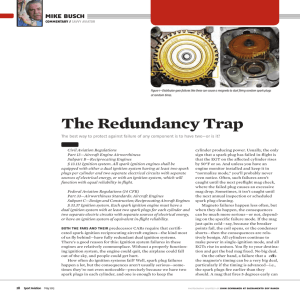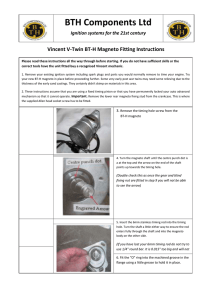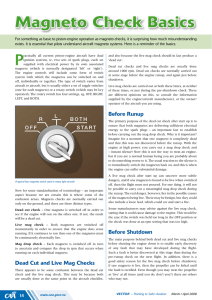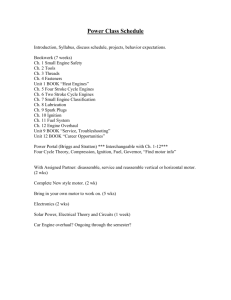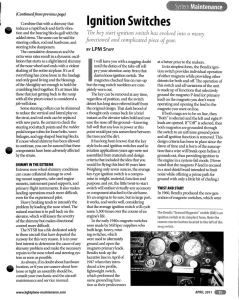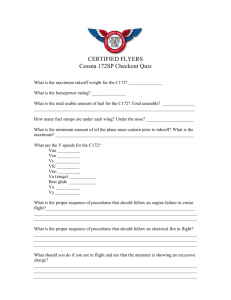File - Sleeping Giant Flying Club
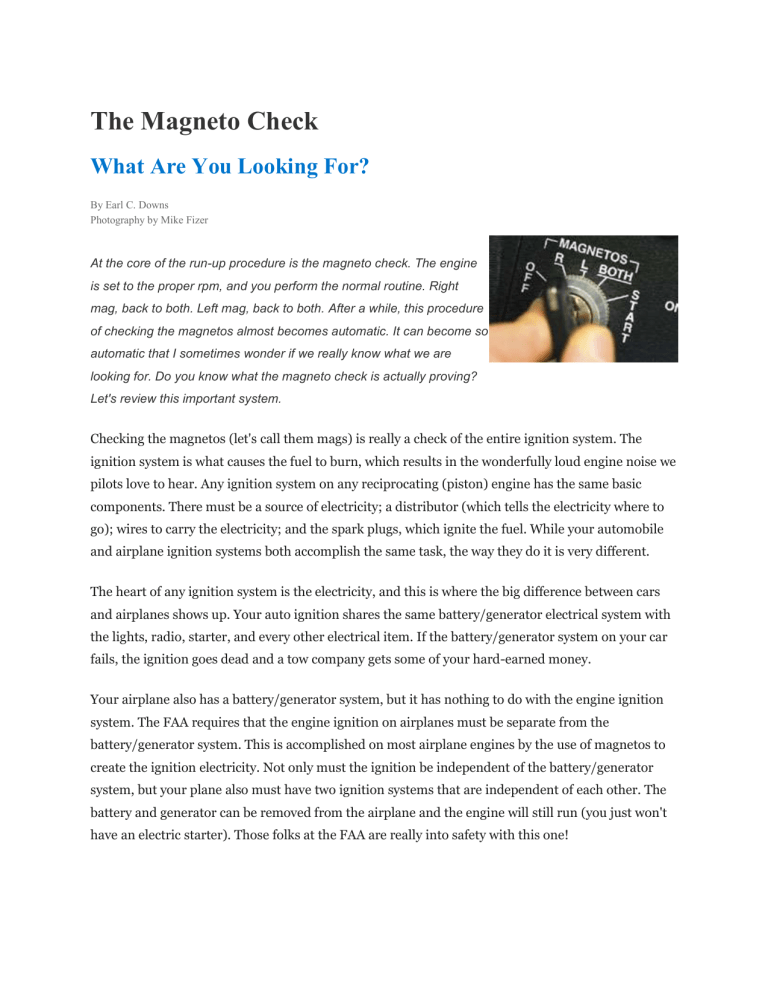
The Magneto Check
What Are You Looking For?
By Earl C. Downs
Photography by Mike Fizer
At the core of the run-up procedure is the magneto check. The engine is set to the proper rpm, and you perform the normal routine. Right mag, back to both. Left mag, back to both. After a while, this procedure of checking the magnetos almost becomes automatic. It can become so automatic that I sometimes wonder if we really know what we are looking for. Do you know what the magneto check is actually proving?
Let's review this important system.
Checking the magnetos (let's call them mags) is really a check of the entire ignition system. The ignition system is what causes the fuel to burn, which results in the wonderfully loud engine noise we pilots love to hear. Any ignition system on any reciprocating (piston) engine has the same basic components. There must be a source of electricity; a distributor (which tells the electricity where to go); wires to carry the electricity; and the spark plugs, which ignite the fuel. While your automobile and airplane ignition systems both accomplish the same task, the way they do it is very different.
The heart of any ignition system is the electricity, and this is where the big difference between cars and airplanes shows up. Your auto ignition shares the same battery/generator electrical system with the lights, radio, starter, and every other electrical item. If the battery/generator system on your car fails, the ignition goes dead and a tow company gets some of your hard-earned money.
Your airplane also has a battery/generator system, but it has nothing to do with the engine ignition system. The FAA requires that the engine ignition on airplanes must be separate from the battery/generator system. This is accomplished on most airplane engines by the use of magnetos to create the ignition electricity. Not only must the ignition be independent of the battery/generator system, but your plane also must have two ignition systems that are independent of each other. The battery and generator can be removed from the airplane and the engine will still run (you just won't have an electric starter). Those folks at the FAA are really into safety with this one!
The airplane's double ignition system provides better performance because of more efficient combustion and a higher level of safety through redundancy. The magnetos produce the electrical power for the spark plugs, and these neat little gadgets have been around for more than 100 years. In its simplest form, a magneto is nothing more than a spinning magnet surrounded by a coil of wire.
Have you ever seen one of those old telephones that had a hand crank on the side? The crank simply provided the turning motion to operate a magneto, which sent out enough electricity to ring the bell on the other end of the line. Modern applications of magnetos include motorcycles, weed trimmers, and wind-up radios, in addition to piston-engine airplanes.
The mags on your plane are gear-driven by the engine. The same gear drive that spins the magnet also spins a distributor that sends the electricity to the correct spark plug at the right time. Each magneto has its own distributor, wires, and spark plugs. Each cylinder has two spark plugs, one for each mag. The mags are attached to the back side of the engine and are about the size of a grapefruit.
They are usually painted black, and the spark plug wires come out of each mag and go to their respective plugs. There you have it - two independent ignition systems that are also independent of the battery/generator system.
In order to understand what you should be looking for while performing the magneto check during the engine runup it's important to understand what the mag switch actually does. The Off position of the magneto switch is different from that of other electrical switches you use. When you switch off the radio, you are removing the electricity from the radio. The Off position of the mag switch does not actually remove electricity from the magneto because the magneto is what makes the electricity.
Remember, any time the magnet in a magneto spins, we get electricity. Think about it - if you move the propeller by hand, the magneto is working.
Turning the mag switch Off actually causes a short circuit (called grounding) in the magneto coil that prevents it from working. The wire that does the grounding is called a P-lead.
Although the mag switch in your plane only shows one, there are really three Off positions. "Off" means that both mags are grounded and should not be able to power their ignition systems.
Remember, grounding only occurs if the P-lead is connected properly. A broken P-lead could cause an engine start if the prop is moved ever so slightly. The other two Off positions on the mag switch are those labeled "L" and "R". When you switch to the left mag (L) you are actually grounding the right mag. If you think about it, the only way to test the left magneto is to switch off the right magneto.
The same holds true for the right mag (R) position. By selecting the right magneto, you shut off the left magneto. Your run-up check proves that each ignition system operates without help from the other one. The Both position of the mag switch removes the ground from both magnetos, and the engine uses the full dual system. The P-leads are key to the operation of the magnetos. A disconnected P-lead on either magneto means that the ignition cannot be shut off in flight or on the ground - and that's dangerous.
Timing is adjusted separately on each magneto so that it fires its spark plugs at exactly the right time.
If the plug fires too early or too late, engine power and engine life can be adversely affected. As the pilot, you don't have any way to know exactly how the mags on your plane are timed, but if your engine malfunctions there are symptoms that can give you clues if the timing is not right.
Let's take a look at your magneto check during an engine runup and review each step. You need to refer to the appropriate operating manual for actual rpm numbers to use during your check.
While running at the recommended power setting, switch the mags from the Both position to the R and L positions. Be sure to go back to the Both position each time you move the switch. You must see a drop in power, but it must not exceed the maximum allowable. Too great a drop in rpm can be an indication of several problems - anything from a fouled plug to a bad ignition wire to improper timing to a bad magneto. It needs to be checked by a mechanic.
No drop in rpm could be an indication of a broken P-lead. You can check this yourself by bringing the engine to idle rpm and placing the ignition switch to Off. If the P-lead is broken, the engine will continue to run. If the P-leads are good, the engine will begin to quit. If it does start to quit, place the mag switch back on before the prop stops turning and the engine will restart. Another cause for little or no rpm drop could be improper magneto timing. When in doubt, have it checked out.
Look for the difference in rpm drop between the left and right magnetos. The operating manual will recommend a maximum allowable difference. Typical is about 50 rpm. It is possible for the rpm drop on each mag to be within limits but the difference between the mags to be excessive. The most common problem here is improper timing of one or both magnetos. Get it checked out. A very small difference between the mags is all right.
How about in-flight problems? A rough-running engine could mean a number of things, so be sure to follow the published procedures. Just because you are running on both magnetos doesn't mean that the remaining mag will automatically compensate for a failure of its partner. If one magneto develops a timing problem it could seriously affect the engine's ability to run. It is important to
switch to the L and R positions to see if the engine will run better on one mag than on both.
Remember, the L and R positions of the mag switch each are shutting off one magneto. If the problem is a bad mag, the engine will run terribly when switched to one position and will run well in the other switch position. It is certainly all right to continue your flight on one magneto to an airport where repairs can be made. The remaining magneto is not working any harder than usual and doesn't even know that its partner has been switched off.
Knowing your airplane is important for safety. Spend time with a flight instructor or a certificated mechanic to learn about the inner workings of your machine.
